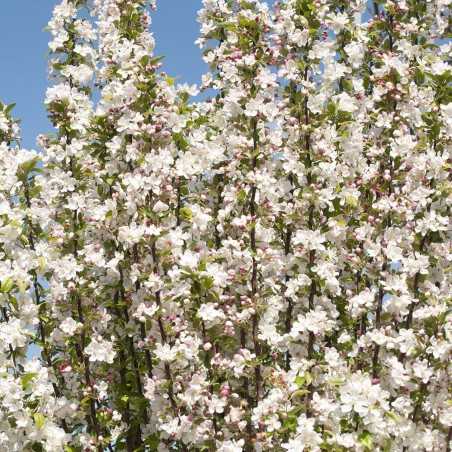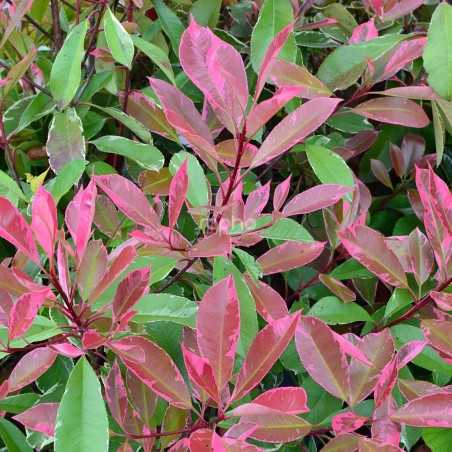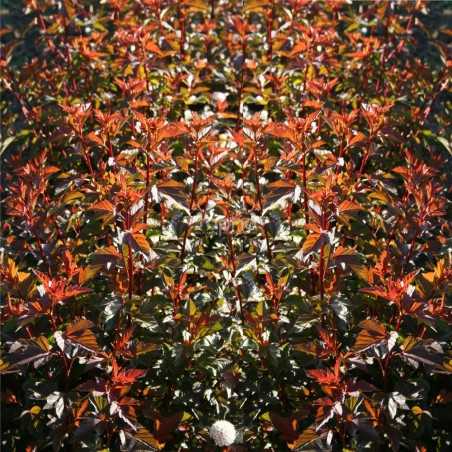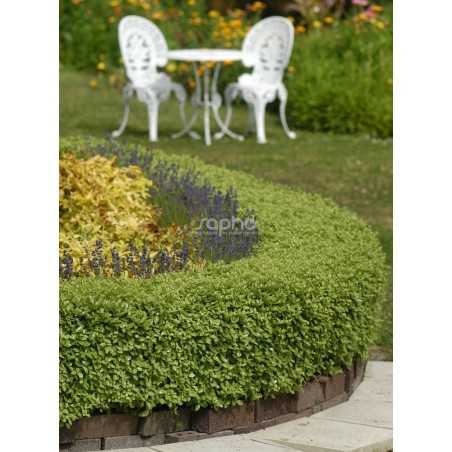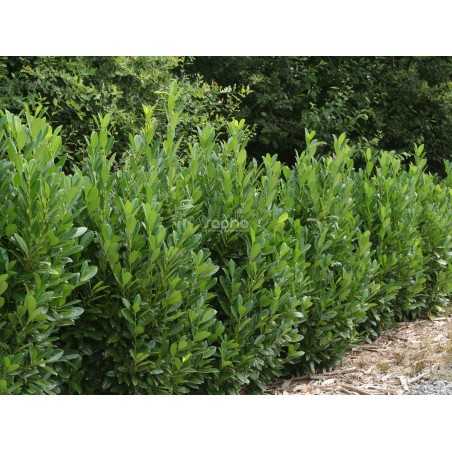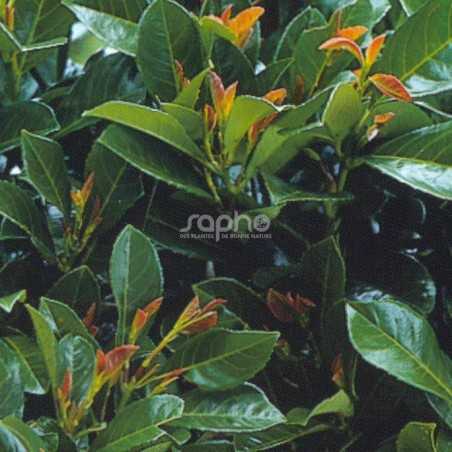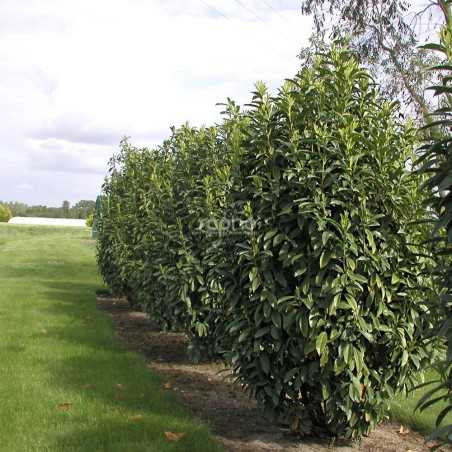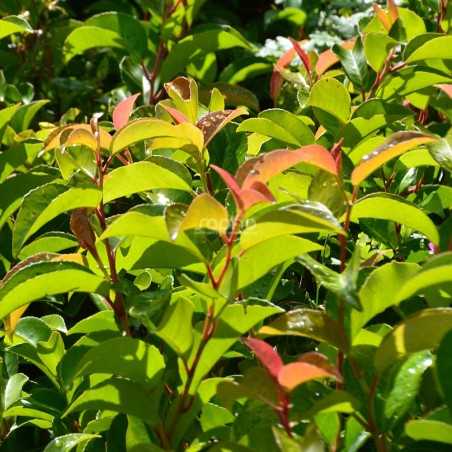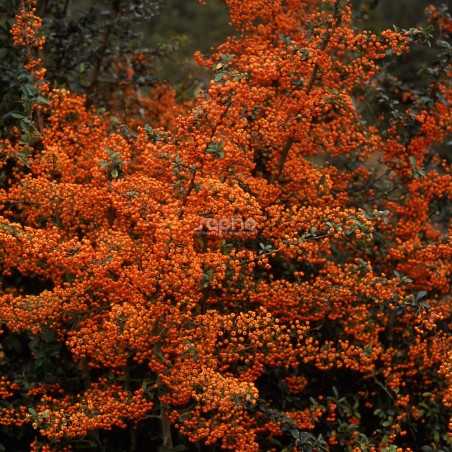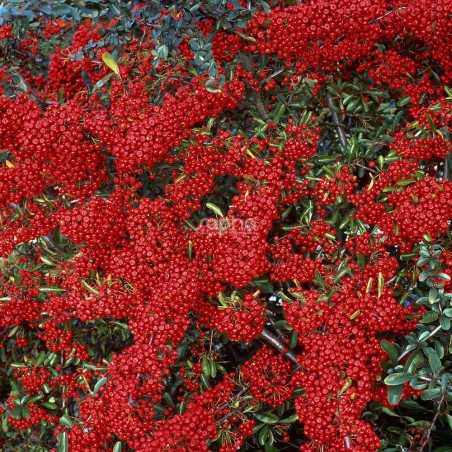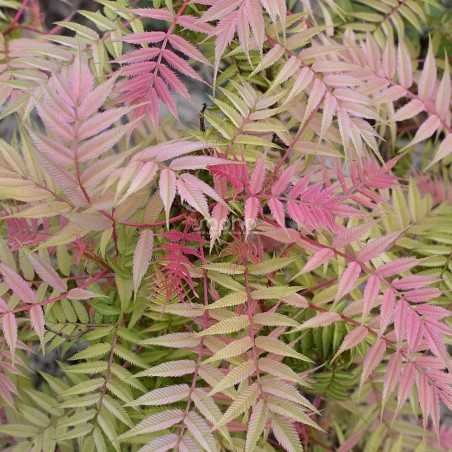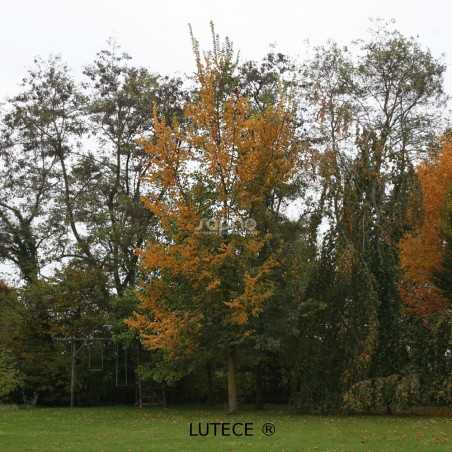Naturally a STAR since its creation.
This tree is of semi-spreading growth, reaching a height of 3 to 4m in ten years and has a harmonious shape, which it keeps without the necessity of pruning. Its foliage is green.
In April, 'Evereste' covers itself in bright pink flower buds, which bloom as pure white bouquets of flowers. The quality and the abundance of its pollen make it an ideal pollinator, precious for fruit growers (in proportion of 6 - 8% of all varieties of early or semi-early flowering).
The cherry sized fruits are orange with thin red stripes. They apprear in autumn and have the particularity to last well into winter.
'Evereste' has also been chosen by the INRAE selectors for its resistance to the major diseases such as fire blight, scab and mildew.
Nearly a million plants have been sold in Europe since its creation in 1974.
Its ornamental qualities, its reasonable dimensions and its easy care make it an excellent small urban tree if grown full standard; in clumps it is very valuable in the composition of flowering hedges and in shrub borders.
Filter By
Foliage
Position
Categories
Menu
Inspirations
Beautifully mixed colours and an upright and regular formIts variegated foliage brings colour throughout the year. Photinia Louise has also been selected for its vigorous, erect growth and its ample vegetation that's regular, compact and dense. Photinia Louise is a shrub with persistent leaves and changing colours. In spring and autumn the young shoots are bright red spotted with pink.The developing leaves become thick and green, spotted wih creamy white. Its flowers, in May, are quite discreet, forming creamy white umbels. Upkeep is easy as it needs little pruning other than that required by the garden. In a hedge, a mixed bed or as a solitary shrub, 2 to 3 m high, Photinia Louise will enliven a garden throughout the year.
In springtime light, pretty copper shimmering foliage.This shrub is remarkable for its dense, deciduous jagged foliage, with its original orange copper shades in spring, turning to purple in summer and autumn. It prefers a sunny position to develop its beautiful colours.It has bushy habit, dense, stocky with strong, straight branches.Small balls of white flowers bloom from May to June. They are followed by red fruits in summer.DIABLE D'OR® suits well in mixed free hedges. Its copper shimmering in springtime, turning to purple later on makes it very precious for creating seasonal variations in the colours of the hedges foliage. The flowers and fruit add to its ornamental value.
Recommended for its low, naturally ball shaped growthThis cultivar originates from New Zealand.?Golf Ball? has a very round shape, not more than 1 m in dimension. It grows rapidly and stands out by its dense branches from the base upwards.Its evergreen foliage is light green.Discrete violet-brown flowers appear in Mai and June. The have a scent of honey but are of no decorative interest. 'Golf Ball' resists rather well to drought, and to temperatures of -5 to -10° C. It is excellent for the sea side because it accepts mist and wind.Recommended for small areas and low hedges, it is also suitable for pots and as topiary, like box.
A hardy selection with well-branched growth, for a maintenance-free hedge.This variety, coming from a Prunus laurocerasus 'Otto Luyken' seedling, was selected for its rapid growth and its well branched and upright habit, resembling a compact flame.It has few flowers in spring, and therefore only a little fruit afterwards.Rustic evergreen, particularly resistant to disease, not needing pruning, 'Greentorch' is an ideal variety for a monospecific hedge without worries.
Little springtime vulcanos for a low hedge.This variety of laurel with elegant branches naturally reaches a height of about 2 m and a spread of 1.50 m, all the while keeping its compact shape. It is of medium to slow growth.The coppery young shoots are decorative and contrast well with the shiny dark green foliage, which is evergreen.The creamy white flowers in May are followed by deep violet berries.ETNA® tolerates pruning and is recommended for the composition of moderate sized hedges (up to 0.80 m). Mixed with other shrubs, it brings an evergreen touch to beds. It can also be used in containers.Trophies: Gold medal at the Plantarium 1994. (Boskoop - NETHERLANDS)
For a naturally narrow and hardy hedge.This Prunus laurocerasus has been cultivated in Switzerland for its erect and narrow growth. It only needs light pruning.It reaches a height of 3,50 m and a width of 1.00 m when free growing.The foliage is shiny dark green, quite elongated and resists well to low temperatures.GENOLIA® does not thin out at the base and can stand the weight of snow thanks to its erect and strong branches.It has discrete flowers and the fruits are not very abundant.This variety is ideal for a narrow hedge.Trophies: Silver Medal at PLANTARIUM 2005 (Boskoop - NETHERLANDS)
Worth a try: a new evergreenThis new evergreen is an asset for the producer: its growth is vigorous and it forms very well. The young shoots offer a pretty bronze shimmer, later the foliage turns bright light green, which contrasts with the red petioles. In the autumn it turns bronze green.The slightly flared and drooping shape as well as the small and curled leaves give the shrub a light and natural silhouette.Very hardy for a Prunus azorica. Ideal for the revival of hedges!
Hardy Pyracantha of the SAPHYR® range with orange berries.This variety has all the characteristics of the SAPHYR® range.SAPHYR® Orange 'Cadange', fast growing, has a profusion of big bright orange berries from September onwards, lasting the best part of the winter.
Hardy Pyrancantha of the ; SAPHYR® range, with red berries.This variety has all the characteristics of the SAPHYR® range.SAPHYR® Rouge 'Cadange', medium fast growing.From September onwards until December, it bears an abundance of big, shiny, bright red berries finally turning orange at the end of the season.
A novelty for the Sorbaria genus : foliage with long lasting colours, a growth that stays compact
Concerning the Sorbaria species, where novelties are rare, PINK HOPI® 'COUSORB05' has been chosen for its qualities, different from those of 'Sem'.The compound, serrated foliage is delicate, light and harmoniously layered. It is a remarkable plant, due to its young variegated shoots which are red, pink and cream, then veined with white. Bud burst is extremely precocious, starting in early March. The shoots withstand the cold (at least up to -3° C). The colourful period lasts a month longer than in the traditional varieties, the shrub shines until the end of Mai. Later, in the summer, the foliage turns green.The shape of PINK HOPI® has the additional advantage of staying compact and this selection produces less suckers. Its dense foliage makes it a good ground cover.The white flower panicles bloom in June - July.The shrub does not need any maintenance (neither treating nor pruning). It is very hardy.
Resistant to the Dutch elm disease, our towns and countryside have found the elm again.
Tested by INRAE, this hybrid is the result of cross fertilization of six French varieties, plus an English and a Chinese one. It is resistant to the Dutch elm disease. Its bark is smooth. The leaves are quite similar to the common elm tree: asymmetrically toothed, with a rough underside. The deep green foliage is dense. In the autumn it has a beautiful golden yellow tint. In March, before the leaves, grow discreet flowers in the shape of little red globules without petals. Its slender trunk gives LUTECE® a perfect aptitude for a high-stem training, better than Ulmus RESISTA® 'Sapporo Gold'; growing naturally its habit is regular and homogeneous. It also makes a very good shrub. It is fast growing. Perfectly adapted to landscape hedges, this cultivation is equally interesting planted in groups on an embankment for example, but also as individual tree or grown in line if it has been grown as a full standard. The name of LUTÈCE® was given to it in recognition of the help provided by Parks and Gardens Department of the city of Paris for having taken care of a field of experimentation in the Vincennes Park.

